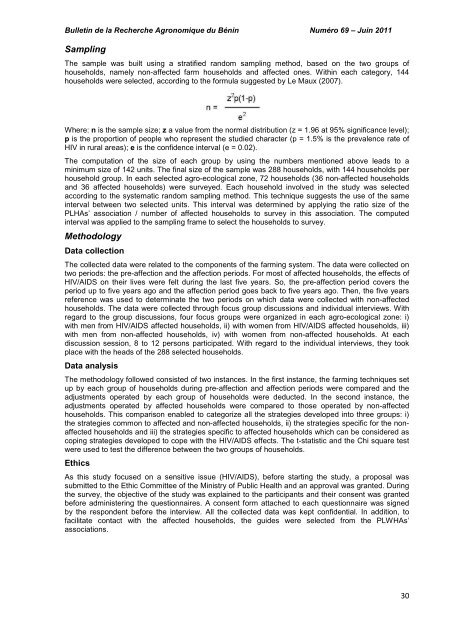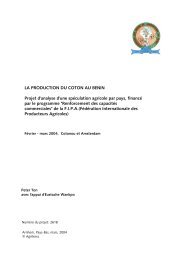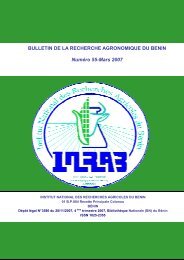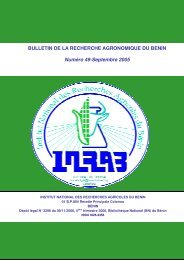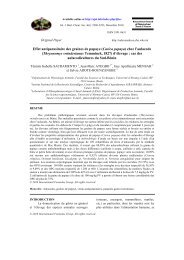Lien externe ou de téléchargement - Slire
Lien externe ou de téléchargement - Slire
Lien externe ou de téléchargement - Slire
- No tags were found...
You also want an ePaper? Increase the reach of your titles
YUMPU automatically turns print PDFs into web optimized ePapers that Google loves.
Bulletin <strong>de</strong> la Recherche Agronomique du Bénin Numéro 69 – Juin 2011SamplingThe sample was built using a stratified random sampling method, based on the two gr<strong>ou</strong>ps ofh<strong>ou</strong>seholds, namely non-affected farm h<strong>ou</strong>seholds and affected ones. Within each category, 144h<strong>ou</strong>seholds were selected, according to the formula suggested by Le Maux (2007).Where: n is the sample size; z a value from the normal distribution (z = 1.96 at 95% significance level);p is the proportion of people who represent the studied character (p = 1.5% is the prevalence rate ofHIV in rural areas); e is the confi<strong>de</strong>nce interval (e = 0.02).The computation of the size of each gr<strong>ou</strong>p by using the numbers mentioned above leads to aminimum size of 142 units. The final size of the sample was 288 h<strong>ou</strong>seholds, with 144 h<strong>ou</strong>seholds perh<strong>ou</strong>sehold gr<strong>ou</strong>p. In each selected agro-ecological zone, 72 h<strong>ou</strong>seholds (36 non-affected h<strong>ou</strong>seholdsand 36 affected h<strong>ou</strong>seholds) were surveyed. Each h<strong>ou</strong>sehold involved in the study was selectedaccording to the systematic random sampling method. This technique suggests the use of the sameinterval between two selected units. This interval was <strong>de</strong>termined by applying the ratio size of thePLHAs’ association / number of affected h<strong>ou</strong>seholds to survey in this association. The computedinterval was applied to the sampling frame to select the h<strong>ou</strong>seholds to survey.MethodologyData collectionThe collected data were related to the components of the farming system. The data were collected ontwo periods: the pre-affection and the affection periods. For most of affected h<strong>ou</strong>seholds, the effects ofHIV/AIDS on their lives were felt during the last five years. So, the pre-affection period covers theperiod up to five years ago and the affection period goes back to five years ago. Then, the five yearsreference was used to <strong>de</strong>terminate the two periods on which data were collected with non-affectedh<strong>ou</strong>seholds. The data were collected thr<strong>ou</strong>gh focus gr<strong>ou</strong>p discussions and individual interviews. Withregard to the gr<strong>ou</strong>p discussions, f<strong>ou</strong>r focus gr<strong>ou</strong>ps were organized in each agro-ecological zone: i)with men from HIV/AIDS affected h<strong>ou</strong>seholds, ii) with women from HIV/AIDS affected h<strong>ou</strong>seholds, iii)with men from non-affected h<strong>ou</strong>seholds, iv) with women from non-affected h<strong>ou</strong>seholds. At eachdiscussion session, 8 to 12 persons participated. With regard to the individual interviews, they tookplace with the heads of the 288 selected h<strong>ou</strong>seholds.Data analysisThe methodology followed consisted of two instances. In the first instance, the farming techniques setup by each gr<strong>ou</strong>p of h<strong>ou</strong>seholds during pre-affection and affection periods were compared and theadjustments operated by each gr<strong>ou</strong>p of h<strong>ou</strong>seholds were <strong>de</strong>ducted. In the second instance, theadjustments operated by affected h<strong>ou</strong>seholds were compared to those operated by non-affectedh<strong>ou</strong>seholds. This comparison enabled to categorize all the strategies <strong>de</strong>veloped into three gr<strong>ou</strong>ps: i)the strategies common to affected and non-affected h<strong>ou</strong>seholds, ii) the strategies specific for the nonaffectedh<strong>ou</strong>seholds and iii) the strategies specific to affected h<strong>ou</strong>seholds which can be consi<strong>de</strong>red ascoping strategies <strong>de</strong>veloped to cope with the HIV/AIDS effects. The t-statistic and the Chi square testwere used to test the difference between the two gr<strong>ou</strong>ps of h<strong>ou</strong>seholds.EthicsAs this study focused on a sensitive issue (HIV/AIDS), before starting the study, a proposal wassubmitted to the Ethic Committee of the Ministry of Public Health and an approval was granted. Duringthe survey, the objective of the study was explained to the participants and their consent was grantedbefore administering the questionnaires. A consent form attached to each questionnaire was signedby the respon<strong>de</strong>nt before the interview. All the collected data was kept confi<strong>de</strong>ntial. In addition, tofacilitate contact with the affected h<strong>ou</strong>seholds, the gui<strong>de</strong>s were selected from the PLWHAs’associations.30


